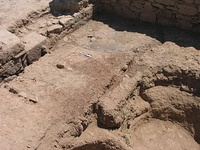| Collection: | Corinth | |
| Type: | Basket | |
| Name: | Nezi Field, context 6631 | |
| Area: | Nezi Field | |
| Context Type: | Fill | |
| Title: | fill above bothros/robbing trench cut | |
| Category: | Deposit | |
| Notebook: | 1103 | |
| Context: | 6631 | |
| Page: | 0 | |
| Date: | 2009/06/11 | |
| Stratum: | 50%: boulders, tiles, small rectangular and subrectangular and subangular stones. | |
| Description: | The soil color is dark reddish brown. The soil compaction is weakly cemented. The soil is poorly sorted. It is sandy silt. | |
| Notes: | We excavated this context in the southeastern corner of the room in order to understand 1) the shape and extent of the bothros cut discovered during the excavation of 6624 2) the relationship of the bothros cut to the surface exposed during the excavation of 6624 and 3) the relationship between the bothros cut and the robbing trench that we have observed for some time in section, cutting red "stereo" soil. We found a number of clarifications to these questions. First, the fill of the bothros cut was revealed going in a semicircular form against the section of wall 5483. Its extent was found to cut into the robbing trench cut (putative) running east-west, which explains why we haven't heretofore found the cut in its entirety. Also, because we now understand that the bothros cuts the trench, and we know that the bothros cuts the robbing surface exposed by context 6624, then we know that the robbing trench cut must ALSO first cut this newly-exposed surface. This was a bit higher than where we expected to locate the line of the cut, but it makes good stratigraphical sense. Finally, the fact that foundation trench cut 6616 cuts at a HIGHER level to the east combined with the fact that we have demonstrated that the foundation trench cut to the east is lower (cutting the newly exposed red/pink surface revealed by 6624), as well as truncated by the bothros cut, we have confirmed that the two phases that we have identified are reflective of two construction events. Final note: we never found the southern edge of the ostensible robbing trench cut, suggesting that the lines of the cut differ from what they once were. Perhaps the cut corners at the previously-discovered robbing trench cut 6381? POST-EXCAVATION NOTE, 15-06-09, S.L.: Contexts 6663 and 6649, at least one of which underlies this context, were found to contain two joining coarse incised ware body fragments of the Frankish period, dating to the mid-13th century. These sherds will stratigraphically change the dates of every context that lies above them by as much as two centuries, of which this context is one. Until it is decided whether there is some other reason that this discrepancy might have occurred (e.g., these contexts need to be situated in a different place on the Harris Matrix), the dates will remain as they have been assigned on the basis of pottery/stratigraphy prior to discovering this discrepancy. | |
| Context Pottery: | Fineware. premedieval13 bodysherds. ; Fineware. sgraffito II, slipped painted (1200-1260), bowl. 1 bodysherd. | |
| Pottery Summary: | 15 frag(s) 0.06 kg. (0% saved) fineware. | |
| 123 frag(s) 2.2 kg. (0% saved) coarseware. | ||
| 23 frag(s) 0.13 kg. (0% saved) cooking ware. | ||
| Context Artifacts: | glass clear colorless trail handle handle 1; clear bluish stem of goblet as MF 57576 [Corinth XII, no. 714, p. 110]; clear brownish pushed-in ring base with slightly sloping base wall base 1; obsidian blade 1; stem 1 clear bluish squashed pushed-in ring base 1 clear bluish bs 2 clear colorless bs 2 | |
| Period: | Late Byzantine (1059-1210 AD) | |
| Chronology: | mid 12th | |
| Grid: | 271.79-269.23E, 1023.57-1025.51N | |
| XMin: | 269.23 | |
| XMax: | 271.79 | |
| YMin: | 1023.57 | |
| YMax: | 1025.51 | |
| Site: | Corinth | |
| City: | Ancient Corinth | |
| Country: | Greece | |
| Masl: | 84.17-84.32m. | |
| References: | Image: digital 2009 2198 Image: digital 2009 2199 Coin: 2009 199 |
|
Classifications Sign in Provide feedback |
|

